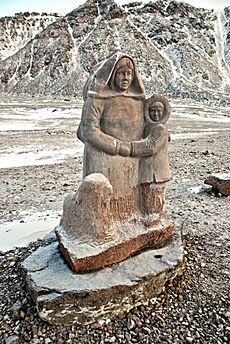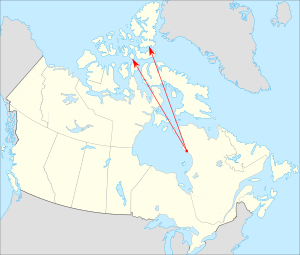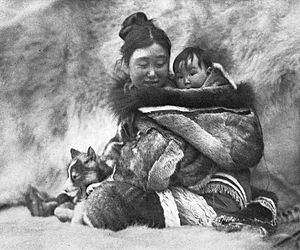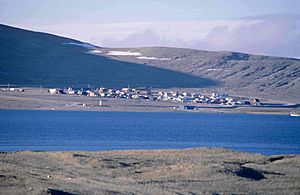High Arctic relocation facts for kids
The High Arctic relocation was a big event in the 1950s. During the Cold War, the Government of Canada moved 92 Inuit families from their homes to the far north. This happened under Prime Minister Louis St. Laurent.
This move has caused a lot of debate. Some people say it was a kind act to help Inuit who were struggling. They say it helped them keep their traditional hunting lifestyle. Others say it was a forced move. They believe the government wanted to show that Canada owned the Far North. This was important because of the Cold War and arguments over land in the Canadian Arctic Archipelago. Everyone agrees that the Inuit did not get enough help. They faced very hard times in their first years after the move.
Contents
History of the Relocation
In August 1953, several families from Inukjuak, northern Quebec, were moved. They went to Grise Fiord on Ellesmere Island and Resolute on Cornwallis Island. The famous writer Markoosie Patsauq and his family were among them.
These families had been getting government help. They were told they would find better hunting and living conditions in the High Arctic. Three families from Pond Inlet also joined them. These families were meant to teach the Inukjuak Inuit how to survive in the High Arctic.
There are different ideas about why the move happened. The government said the families volunteered. They wanted to reduce too many people in Northern Quebec. They also wanted to help Inuit rely less on government help. The goal was for them to return to a traditional hunting lifestyle.
However, the Inuit said they were forced to move. They believed the government wanted to put people in the Arctic. This would help Canada claim ownership of the Canadian Arctic Archipelago. The Inuit were taken on a ship called the CGS C.D. Howe. They went to Resolute and Grise Fiord, which are very cold, barren islands. On the ship, the families learned they would be split up. They would live in three different places.
Some experts believe the relocation was an experiment. It was also seen as a way to solve the "Eskimo problem." The government said Inuit were not giving up their traditional ways. They also said some areas were too crowded. They even shared stories of poor hunting and hunger in Inukjuak. But the government knew that hunting was bad because of a natural animal cycle.
Life in the New Communities
The families arrived with very few supplies. They did not have enough food, caribou skins, or materials for clothes and tents. They had moved about 2,000 kilometers to a completely new place. The animals were different, and they had to learn new hunting methods.
They also had to get used to extreme light changes. In winter, it was dark for 24 hours a day. In summer, the sun shone for 24 hours a day. This was very different from northern Quebec. The government had promised to move them back after two years if they wanted. But this promise was not kept.
Some of the relocated Inuit had been part of a film called Nanook of the North. This included Josephie, the son of the filmmaker Robert J. Flaherty. Over time, the Inuit learned the routes of beluga whales. They learned to hunt over a huge area. They were able to survive in their new homes. Reports from the Royal Canadian Mounted Police (RCMP) said the communities were doing well. They had good spirits, homes, and food.
Looking Back at the Relocation
In the 1980s, the relocated Inuit and their children started a legal case. They said the main reason for their move was to help Canada claim the Arctic. In 1987, they asked the government for $10 million.
Because of public pressure, the government started a program. It helped Inuit return to their old homes. In 1989, 40 Inuit went back. This sometimes split families, as younger people often chose to stay in the High Arctic. Those who stayed are very dedicated to their new homes.
In 1990, a government committee asked for an apology. They also asked for money for the Inuit. They wanted the government to recognize the Inuit's service to Canada's ownership of the Arctic. The government then ordered a report called the "Hickling Report." This report said the government did nothing wrong. It claimed the Inuit had volunteered and moved because of hard times in Inukjuak. Many people criticized this report.
However, another report in 1991 disagreed. It said there was clear proof that the government cared about Arctic ownership. It also said the settlements would help Canada's claim. This report concluded that the government broke its promise. It did not let the Inuit return home after two years. Another report by Magnus Gunther said the government had good intentions. Because of this, the Minister of Indian Affairs and Northern Development said an apology was not needed.
In 1994, the Royal Commission on Aboriginal Peoples held hearings. The Inuit strongly said they were forced to move. Government officials said the Inuit moved willingly. The Commission found that the government wanted to "help" the Inuit. They wanted to move them to better hunting lands. But the government did not prepare enough for them.
The Commission suggested an apology and money for the survivors. It also wanted the government to recognize the Inuit's role in showing Canada's presence in the Arctic. The report said that Inuit settlements did help Canada's claim. But it also said that showing ownership was not the main reason for the decision at the time. The report concluded that the relocation was not a good solution. It said that ownership was a key factor.
The government refused to apologize at first. But in 1996, they created a $10 million fund for the families. The government admitted the Inuit suffered "hardship, suffering and loss." But it also asked recipients to agree that officials had "honourable intentions."

Finally, on August 18, 2010, an official apology was given. John Duncan, the Minister of Indian Affairs, apologized for the "dark chapter" in Canada's history. He praised the Inuit for their strength. He said this history must be remembered and taught to children.
Even today, the term The Relocated is very emotional for many people.
In the Media
Artists Looty Pijamini (from Grise Fiord) and the late Simeonie Amagoalik (from Resolute) created monuments. These monuments honor the Inuit who suffered from the relocation. Pijamini's monument in Grise Fiord shows a woman, a boy, and a husky. The woman looks sadly towards Resolute Bay. Amagoalik's monument in Resolute shows a lone man looking towards Grise Fiord. These statues show families separated and longing to see each other. Pijamini said he made them look sad because the relocation was not a happy event. The monuments were revealed in 2010.
The High Arctic relocation is also the topic of several films. Zacharias Kunuk made a film called Exile. This film was produced by Isuma, who also made Atanarjuat: The Fast Runner. That was the first movie made entirely in Inuktitut.
Other films include Broken Promises - The High Arctic Relocation (1995) by Patricia Tassinari. There is also Martha of the North (2008) by Marquise Lepage. This film tells the story of Martha Flaherty, who was moved at age 5. Lepage also made a web series in 2013 called Iqqaumavara. It shares stories from other people affected by the move.
Larry Audlaluk was a baby when his family was moved to Grise Fiord in 1953. His father died soon after. Larry's book, What I Remember, What I Know: The Life of a High Arctic Exile (2020), shares his personal story. It describes the dangers and sadness they faced.
See also
 In Spanish: Reubicación del Alto Ártico para niños
In Spanish: Reubicación del Alto Ártico para niños
- Dislocation of Sámi people
- Environmental inequality in Europe
- Human migration
- Human rights in Canada
- Indian removal
- Thule relocation





